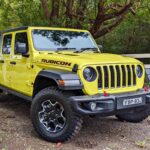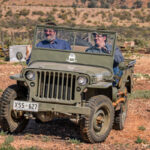![]()
Jeep’s Gladiator was inevitable, as sure as four doors follow two.
Launched here in 2020, it’s a tough-looking, dual cab, five-seat utility with storied off-
road credentials.
Gladiator is a competitor for Toyota’s Hilux Rogue, Ford Ranger Raptor and other
range-toppers, and comes with a sizeable price tag to match.
Although tradies have an affinity for flashy 4×4 dual cab utes, oddly you don’t see
many driving a Gladiator. In fact, you don’t see many of them full stop.
Maybe they are more interested in the look than taking their shiny new toys off road –
– perhaps Gladiator is a little hard core for the wife and family?
STYLING
It’s an eye-catching thing, with a hint of monster truck, riding high with fender flares
and chunky off-road rubber.
Wrangler’s removable roof panels are retained, along with a windscreen that folds
flat and removable lightweight aluminium doors.
Two versions of Gladiator are offered: the city focused Night Eagle, priced from
$73,450 and bush-bashing Rubicon priced from $82,250 — both before on-roads.
Premium paint adds $795, with a choice of three option packs: Lifestyle ($2950),
Premium ($2950) and Trail Ready ($2000).
A spray-on tub liner and tonneau cover are also optional.
![]()
Our test vehicle was the hardcore Rubicon with all the bells and whistles.
So far this year Jeep has sold 1200 Gladiators. This compares with 54,000 Hiluxes
and 38,000 Rangers (we don’t have separate figures for specific grades).
The big difference between Gladiator and other utes is that it is a purpose-built off-
roader unlike competitors that start life as commercial vehicles.
The choice of powertrains is likely to be a deciding factor in the purchase process,
because Gladiator is available only with a 3.6-litre petrol V6 that is sure to guzzle
gas.
In fact, the entire Jeep range is currently available only with a petrol engine, apart
from the top of the range Compass which retains a diesel.
The diesel has been gradually phased out, no doubt in preparation for a hybrid or
perhaps fully electric replacement.
Rubicon features 17-inch alloys with BFGoodrich Off-Road rubber, dual zone climate
air with rear vents and heated leather seats along with a heated steering wheel.
There’s also LED lighting front and back, LED daytime running lights, auto lights and
wipers, auto dimming rear view mirror, plus front and rear parking sensors.
Gladiator comes with a 5-year/100,000km warranty, lifetime roadside assistance if
you service the vehicle through Jeep and needs to be serviced every 12
months/12,000km.
INFOTAINMENT
Infotainment consists of an 8.4-inch touchscreen, 7.0-inch driver info panel and 9-
Speaker Alpine premium audio, with built-in navigation, Bluetooth phone and audio,
AM/FM/DAB+ radio, Apple CarPlay and Android Auto.
![]()
The lower dash offers USB-C, USB-A and AUX ports, along with a 12-volt outlet.
ENGINES / TRANSMISSIONS
The 3.6-litre Pentastar V6 generates 209kW of power at 6400 rpm and 347Nm of
torque at 4100 rpm, with drive to the rear wheels most of the time through an eight-
speed automatic transmission fitted with auto engine stop-start.
SAFETY
Standard safety extends to four airbags (two front and two side), with Autonomous
emergency braking (City and Interurban) and a blind spot monitor.
Forward Collision Warning Plus, Adaptive Cruise Control with Stop, Blind Spot
Monitor and Rear Cross Path Detection.
Lane Keep Assist (LKA) and Emergency Lane Keeping (ELK) systems are not
available.
Be aware, however, Gladiator receives only three out of a possible five stars for
crash performance.
DRIVING
In the UK the 4×4 scene is about mud and bog holes. In the United States, it’s more
about water crossings and rocky hill climbs. In this great land of ours, going off road
is likely to include a mix of both, with the Outback regarded as the pinnacle of off-
road adventure.
It’s a market still dominated by Toyota in its many shapes and forms as we
discovered on a recent trip to the Top End behind the wheel of a Prado wagon.
Jeeps and Land Rovers are a comparatively rare sight on the corrugated dirt Gibb
River Road which stretches more than 600km between Broome and Kununurra in
Western Australia.
Conspicuously absent is the darling of the western suburbs, the Ford Ranger.
Where does Gladiator fit into this scenario?
It’s very much a lifestyle choice, with the focus on play rather than work.
It’s about going bush for the weekend, with your mates and your dirt bikes, with
plenty of room in the back for the rest of the gear.
When we started driving Jeeps, they had two doors and a cramped, emergency rear
seat.
Then the four-door Unlimited came along and opened up a whole new world.
Since then, the market for 4×4 dual cab ute market has taken off, accounting for
three of the top 10 selling vehicles in Australia.
Jeep obviously wants a piece of that action and in June, 2020 the Gladiator (what a
great name) was added to the mix, based on the four-door model with a proper
ladder chassis.
At 5591mm in length, Gladiator is long, 71cm longer than the four-door and almost
1.3 metres longer than the original two-door Wrangler.
Parked side by side with a Hilux it looks about the same length, but it’s actually 27cm
longer, which could make the difference between getting in the garage — or not. It’s
also 21cm longer than the Raptor — but still 24cm short of a so-called ‘full-size truck’
such as the RAM 1500.
That length can pose problems when it comes to parking and manoeuvring, with a
13.6 metre turning circle that will see you making plenty of three-point turns.
Convex exterior mirrors make judging distance to objects difficult. You see one thing
in the mirrors and another in the rear-view camera which is a trifle confusing.
Weighing in at 2242kg, aluminium is used to reduce weight and boost fuel
consumption, including the doors, door hinges, hood, fender flares, windshield frame
and tailgate.
Hollow track and stabiliser bars, aluminium engine mounts and steering gear also
help to reduce weight.
It can carry a 693kg and it can tow a 2721kg braked load.
The inside is a mix of old and new styling with a traditional flat dash that contains a
square touchscreen and old-style analogue instrument gauges that flank a central
information panel, though speed can be displayed digitally.
The driver sits close to the wheel and the swap from left to right hand drive hasn’t
been seamless, with a smaller driver’s side footwell that has no room for a footrest.
The back seats can be folded to reveal additional lockable storage underneath and
the whole lot can be hosed out if it comes to that, with removable carpet and drain
plugs.
With an 83-litre tank, fuel consumption is rated at 12.4L/100km, giving it a theoretical
range of 670km.
It’s a feisty thing, fun to drive with a decent turn of speed, but we would have
preferred a diesel.
The steering is rubbery and it has a tendency to wander if left unchecked, but the
ride is surprisingly compliant and unlikely to generate complaints.
After just over 300km of mixed driving, some off road, we were getting 14.0L/100km
which is a little steep for our likes.
Rubicon features a long list of 4×4 accessories, with a high/low range Rock-Trac
Active On-Demand 4×4 system with a traditional, short stubby transfer lever.
Highlights include heavy duty Dana axles, Tru-Lok front and rear electronic diff locks,
electronic front sway-bar disconnect, 77.2:1 crawl ratio and Fox aluminium-bodied
two-inch diameter shocks front and back.
With an approach angle of 40.7 degrees, break over angle of 18.4 degrees,
departure angle of 25.1 degrees and a ground clearance of 249mm, it has a wading
depth of 760mm.
An Off-Road+ Button automatically adjusts throttle, Selec-Speed Control, Traction
Control, Transmission Shift Mode.
It has two modes: 4HI for higher speed sand performance and 4LO for very low
speed rock-hopping manoeuvres
Gladiator gets the “Trail Rated” stamp of approval testifying to its 4×4 capabilities,
but as we have shown previously its meaning is somewhat dubious.
Despite all this, we managed to get the Rubicon bogged in the first mud hole we
encountered on a track that we have traversed many times.
Maybe it was just bad luck, but it left the ute stranded, with all four wheels spinning
uselessly, water up to the top of the rims.
Forward or reverse progress was impossible and we were forced to get on the
blower for help.
Two tow ropes and a winch later the Jeep was finally mobile again, but at the cost of
a bruised ego and a couple of cartons of beer.
Thanks, Bob, Brad and Taylor.
SUMMING UP
Price doesn’t seem to be an object these days, because you won’t get much change
out of $90K by the time you put this Gladiator on the road.
But the lack of diesel or some other more fuel-efficient means of propulsion is likely
to be a stumbling block in a 4×4 ute market that is dominated by diesels.
I’m sure Jeep is well aware of this, but they’re stuck with what they have, at least for
the time being.
As for the Gladiator’s off-road performance. Well, it is what it is . . .
RATINGS:
Looks: 8.5
Performance: 7.5
Safety: 6
Thirst: 6
Practicality: 6
Comfort: 6.5
Tech: 7.5
Value: 7
Overall: 6.9
AT A GLANCE
MODEL RANGE
Jeep Gladiator Night Eagle 3.6L V6, $73,450
Jeep Gladiator Rubicon 3.6L V6, $82,250
Note: These prices do not include government or dealer delivery charges. Contact
your local Jeep dealer for driveaway prices.
SPECIFICATIONS (Jeep Gladiator Rubicon 3.6-litre Pentastar V6 petrol, 8sp
automatic, 4×4, 4-dr utility)
ENGINE:
Capacity: 3.604 litres
Configuration: Six cylinders V configuration
Maximum Power: 209 kW @ 6400 rpm
Maximum Torque: 347 Nm @ 4100 rpm
Fuel Type: Unleaded petrol
Combined Fuel Cycle (ADR 81/02): 12.4 L/100km
DRIVELINE: 8-speed automatic, Rock-Trac Active On-Demand 4×4
DIMENSIONS, WEIGHT AND CAPACITIES:
Length: 5591 mm
Wheelbase: 3488 mm
Width: 1894 mm
Height: 1905 mm
Turning Circle: 13.6 metres
Kerb Mass: 2242 kg
Fuel Tank Capacity: 83 litres
BRAKES:
Front: Ventilated disc
Rear: Disc
STANDARD WARRANTY:
Five years/unlimited kilometres











